
The minor shoulder-knot is a moth of the family Noctuidae. The species was first described by Johan Christian Fabricius in 1776. It is distributed throughout Europe then east across the Palearctic to Siberia and Japan. It also occurs in Turkey.
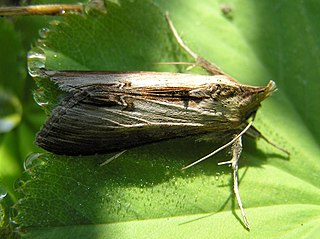
Cucullia asteris, or star-wort, is a moth of the family Noctuidae. The species was first described by Michael Denis and Ignaz Schiffermüller in 1775. It is found through the Palearctic including Japan.

Polia bombycina is a moth of the family Noctuidae. It is found in the Palearctic realm from Ireland to Japan including the Russian Far East and Siberia.

Cucullia argentea, the green silver-spangled shark, is a moth of the family Noctuidae. The species was first described by Johann Siegfried Hufnagel in 1766. It is found in southern and central Europe through Siberia, Mongolia and Manchuria up to Korea and Japan.

Catocala nymphagoga, the oak yellow underwing, is a moth of the family Erebidae. It is found in Southern Europe, from Bulgaria up to the Iberian Peninsula and sometimes further north as a migrant. It is also found in North Africa and Asia Minor.
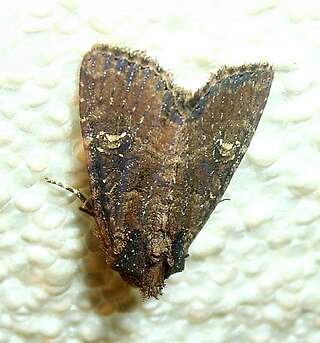
Apamea unanimis, the small clouded brindle, is a moth of the family Noctuidae. The species was first described by Jacob Hübner in 1813. It is native to Europe, Turkey, Azerbaijan, and western Siberia. It has been introduced in North America and can now be found in Ontario, Quebec, New Brunswick, New York, Michigan, and Wisconsin.
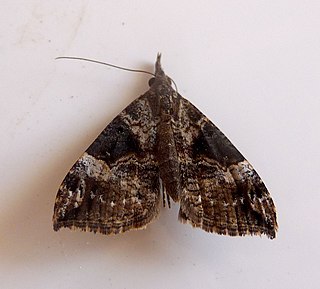
Hypena obsitalis, the Bloxworth snout, is a moth of the family Erebidae. It is found in the Mediterranean Basin including North Africa and in the Near East and Middle East, south up to the Sahara. Further north it is a migrant which occasionally establishes.

Xylena vetusta, the red sword-grass, is a moth of the family Noctuidae. The species was first described by Jacob Hübner in 1813. It is found in the Palearctic realm from northwestern Africa through Europe and Asia up to central Siberia. In the north it is found up to the Arctic Circle and Iceland.

Cucullia santolinae is a moth of the family Noctuidae. It is found in southern Europe, northern Africa, Turkey, the Caucasus region and Israel.
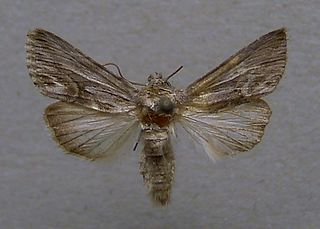
Calophasia platyptera, the antirrhinum brocade, is a moth of the family Noctuidae. The species was first described by Eugenius Johann Christoph Esper in 1788. It is found in Europe, the Near East, the western Sahara, Morocco, Algeria and Tunisia.
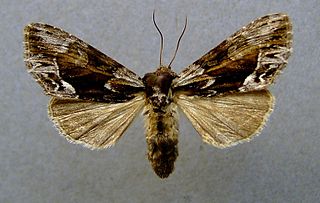
Hyppa rectilinea, the Saxon, is a moth of the family Noctuidae. It is found in Europe, but mostly in northern and central Europe. In the south, it is found in scattered populations, mainly in mountainous areas. To the east, its range stretches through northern Asia and eastern Siberia, up to the Pacific Ocean and Japan.

Cucullia absinthii, the wormwood, is a moth of the family Noctuidae. The species was first described by Carl Linnaeus in 1761. It is found from Europe to the Caucasus, Turkey, northern Iran, western Siberia, the Altai mountains, Tien-Shan and Tarbagatai.

Archanara dissoluta, the brown-veined wainscot, is a moth of the family Noctuidae. The species was first described by Georg Friedrich Treitschke in 1825. It is found in most of Europe, east into Russia and Siberia.
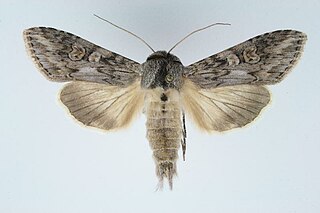
Cucullia artemisiae, or scarce wormwood, is a moth of the family Noctuidae. The species was first described by Johann Siegfried Hufnagel in 1766. It is found from central and southern Europe to Turkey and across the Palearctic to western Siberia, Central Asia, Manchuria, the Korean Peninsula and Japan.

The false water betony is a moth of the family Noctuidae. It is found from south-eastern France, through the Alps and bordering mountains east to Romania and Bulgaria. It is also found in Anatolia and Lebanon.
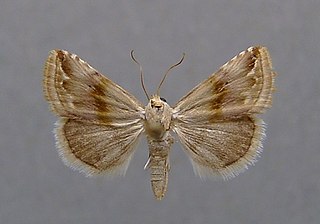
Eublemma ostrina, the purple marbled, is a moth of the family Erebidae. The species was first described by Jacob Hübner in 1808. It is mainly found in central and southern Europe, and further east, but is also a scarce migrant in the United Kingdom, where it is mainly found along the south coast.

Cucullia xeranthemi is a species of moth of the family Noctuidae. In southern Europe, it is found locally from northern Spain, Italy and southern France to the Balkans. In the east, it is found from Lower Austria and Hungary to southern Russia and western Siberia.

Acosmetia caliginosa, the reddish buff, is a moth of the family Noctuidae. The species was first described by Jacob Hübner in 1813. It is found throughout continental Europe and in southern Scandinavia. then east across the Palearctic to Siberia.

Mniotype adusta, the dark brocade, is a moth of the family Noctuidae. It was described by Eugenius Johann Christoph Esper in 1790. It is found throughout much of the Palearctic from Europe to Japan, China and Mongolia. It is also found in North America. The habitat consists of heathland, chalky downland, fenland, moorland and upland areas.

Archanara neurica, the white-mantled wainscot, is a nocturnal moth of the family Noctuidae described by Jacob Hübner in 1808. It is found in Austria, Belgium, Bosnia and Herzegovina, Great Britain, Bulgaria, Croatia, the Czech Republic, Denmark, France, Germany, Hungary, Italy, Latvia, Liechtenstein, North Macedonia, Poland, Romania, Sicily, Slovakia, Slovenia, Switzerland, the Netherlands and Serbia. In the UK, its only regular sites are at RSPB Minsmere and Walberswick National Nature Reserve in Suffolk.






















